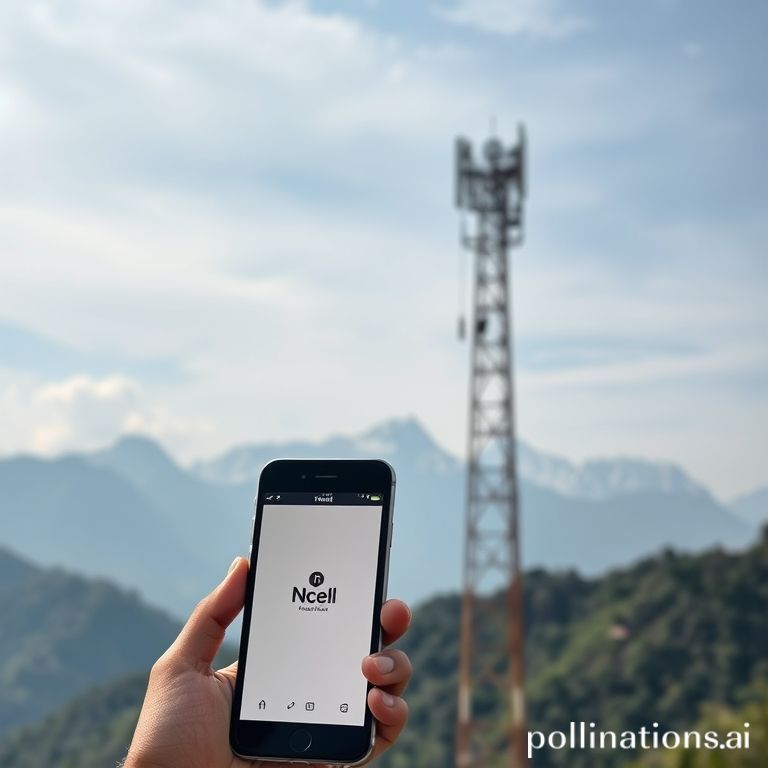How Mobile Data Really Works in Nepal: Inside Ncell and NTC Core Networks
Ever wondered what magical journey your data takes from your phone to the internet and back, especially here in Nepal? We're so used to tapping an icon and instantly browsing, streaming, or chatting, but there's a complex, fascinating world operating behind the scenes. Let's peel back the layers and explore how mobile data truly works within the core networks of Nepal's biggest telecom providers: Ncell and NTC.
The Journey Begins: Your Phone to the Tower
It all starts with your smartphone. When you hit that "send" button or load a webpage, your device converts that request into radio waves. These waves travel a short distance to the nearest mobile tower (Base Transceiver Station - BTS) that your network (Ncell or NTC) operates.

Image 1: A mobile phone's signal reaching an Ncell BTS tower in Nepal.
Each BTS tower acts like a local hub, handling communication with all the mobile devices in its vicinity.
Into the Radio Access Network (RAN)
Once your data reaches the BTS, it enters the Radio Access Network (RAN). This isn't just one tower; it's a whole system of interconnected towers and their controllers. For 4G (LTE), the BTS is known as an eNodeB. The eNodeB's job is to manage radio resources and ensure your data gets efficiently forwarded.
The RAN's primary role is to provide connectivity between your mobile device and the core network. Think of it as the nervous system that gathers all the raw data from individual users.
The Brains of the Operation: The Core Network
Now, this is where things get really interesting! Once your data leaves the RAN, it dives deep into the heart of the mobile network: the Core Network. This is a highly sophisticated, robust, and redundant system responsible for managing all aspects of mobile communication – voice, SMS, and most importantly for us, data.
Both Ncell and NTC operate their own core networks, which, while having different physical locations and equipment, follow similar architectural principles based on international telecommunications standards.
Key Components of a 4G (LTE) Core Network (EPC - Evolved Packet Core):
Here are the main players in the Ncell and NTC data game:
- MME (Mobility Management Entity): This is like the air traffic controller for your phone's connection. It handles signaling, tracks your location as you move between cell towers, and manages authentication and security procedures when you attach to the network. It doesn't deal with the actual data packets themselves but sets up the pathways.

Image 2: Inside the hypothetical Ncell/NTC Core Network Data Center, highlighting MME and SGW functions.
- SGW (Serving Gateway): This is the local data router within the core network. It receives data from the eNodeB and forwards it towards the internet or other parts of the core. If you're moving between cell towers within the same MME service area, the SGW ensures your data session remains active without interruption.
- PGW (PDN Gateway - Packet Data Network Gateway): This is the most crucial component for your internet access! The PGW is the actual interface between the mobile network and the external internet. It assigns your phone an IP address (just like your home Wi-Fi router does), enforces quality of service (QoS) policies, and acts as the gatekeeper, directing your data packets out to the internet and bringing internet traffic back to your phone.

Image 3: The PGW acts as the final gateway between the internal mobile network and the global internet.
- PCRF (Policy and Charging Rules Function): This component works in the background, making real-time decisions about how your data is treated. It tells the PGW about your specific data plan – how much data you have, your speed limits, and whether you're eligible for certain services. This is where your data package rules are enforced.
- HSS (Home Subscriber Server): This is the central database that stores all your subscriber information – your phone number, the services you're subscribed to, your authentication credentials, and your current location within the network. When you power on your phone, the HSS is queried to verify who you are and what services you're allowed to use.
From Core Network to the World Wide Web
Once your data passes through the PGW in Ncell or NTC's core network, it then enters the vast expanse of the internet. Both companies have high-capacity fiber optic links that connect their core networks to international internet backbones, usually via India or directly to international peering points. This is how your request to watch a YouTube video hosted in the USA or send a message to a friend in Australia actually reaches its destination.
The Return Journey
When you request a webpage, the data travels back from the internet, through the international links, hits the PGW of your network, then the SGW, then the MME (for signaling), back to the eNodeB, and finally, as radio waves, to your phone. All of this happens in milliseconds!
Ncell vs. NTC: Similarities and Differences
While both Ncell and NTC use the same fundamental 3GPP (3rd Generation Partnership Project) standards for their 4G (and older 2G/3G) networks, there are operational differences:
- Infrastructure: Each company has its own physical infrastructure – towers, fiber optic cables, data centers housing their core network equipment.
- Capacity & Coverage: Their investment in network expansion, backhaul capacity, and core network equipment determines their overall coverage and data speeds in different areas.
- International Gateways: While they both connect to the global internet, the specific international transit providers and routes they use might differ, potentially affecting latency to certain destinations.
- Operational Scale: NTC, being the older and government-owned entity, has a historically larger fixed-line and broader mobile footprint, while Ncell, as a private player, often focuses on urban density and cutting-edge mobile technologies.
The Future: 5G and Beyond
As Nepal moves towards 5G, the core network will evolve further with technologies like Network Slicing and Multi-access Edge Computing (MEC). These will bring even lower latency, higher speeds, and enable new applications by bringing data processing closer to the user.
So, the next time you effortlessly browse the internet on your phone in Nepal, take a moment to appreciate the intricate dance of radio waves, fiber optics, and sophisticated network components working in harmony within the Ncell and NTC core networks. It's a testament to modern engineering, keeping us all connected!
Comments